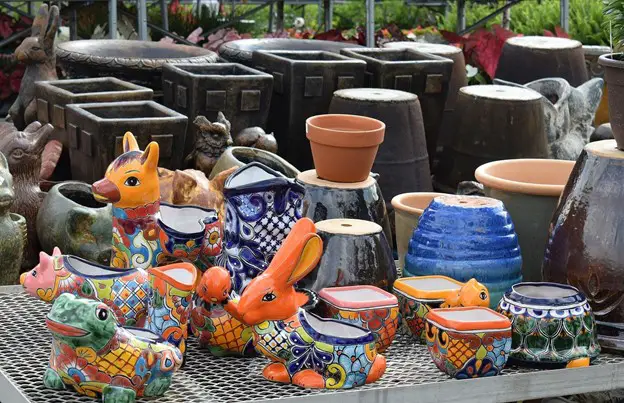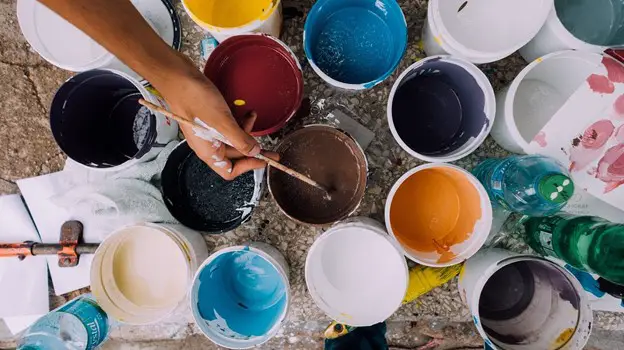Glazing is an important part of the pottery process and helps preserve the pottery along with the colors added to it. However, with time the glaze might wear off, and you might have to repaint the ceramics to retain its luster. In addition, when painting on a glazed surface, the paint fails to stick onto the surface. This means your glazed surface would be unsuited for painting.
To ensure that the paint sticks to the glazed surface, you can follow certain procedures and methods that help get the job done with ease.
Step-by-step process to paint glazed pottery
Before you start painting your pottery piece, here are the steps you need to follow:
Step – 1
The first thing you need to do is sand down the pottery piece with the help of 150-grit sandpaper. When you do this, the ceramic surface becomes textured, and the paint can stick to it easily. After you are done sanding the pottery piece, clean off the dust remnants using a clean rag.
Here are some variants of sandpaper that are used for the sanding process:
Ceramic Sandpaper |
Garnet & Flint Sandpaper |
Silicon Carbide Sandpaper |
| It is extremely durable and hard | Features soft grit & tends to wear out very fast (produces very smooth surfaces) | Features a friable surface that self-sharpens when sanding harder materials |
| Best for use with the powder sanders like orbital sanders | Ideal for sanding down wooden or similar projects | Best for use with dry or wet surfaces that feature a waterproof backing |
| It might be a bit expensive | Economical yet not durable enough | Expensive as compared to others |
Step – 2:
Next, paint your pottery piece with the help of a primer. Using primer serves as a bonding agent between the surface and the paint. When the primer is painted over this textured surface, it creates a strong bond to hold the new paint layer. Make sure you let the primer dry out completely before you start painting.
Step – 3:
Now paint your pottery piece with the help of oil-based paint and even ceramic paint, depending on your choice. Make sure you use uniform painting strokes and move in one direction to get a smooth coating.
Step – 4:
Finally, leave your pottery piece to dry out in an airy space for a minimum of 24 to 48 hours. Make sure you do not touch the surface before it dries out completely, or it can lead to smudging of the paint.
To ensure that the surface becomes completely waterproof, you can spray some gloss or matte sealer on the surface. The best option to try out is Liquitex Basics Matte Varnish. This matte varnish can also be mixed along with its gloss variant to obtain a glossy sheen. Moreover, the varnish dries out, giving a clear and non-yellowing finish.
Make sure you keep your freshly painted pottery item at a distance from any sharp objects that might damage its painted surface. Apart from this, you also need to keep in mind that the ceramic work should be sprayed on with a light coating of sealer. This ensures that your pottery will dry out with zero visible drips.

How to remove the glaze from your pottery item?
If you plan on changing the glaze or completely recoating with paint, the pottery piece must be glazed down. To do this, the best way is to sand the surface until the inner layer is exposed. However, make sure to keep the piece away from water or moisture as sanding down exposes the absorbent layers of the ceramic.
In order to remove the glaze from your pottery work, you need to:
Step – 1:
Take sandpaper (220 grits) and attach it to the orbital sander. This can also be done manually with your hands. However, that is fine if you plan on sanding a small part of the pottery item. For a bigger batch or big pottery piece, orbital sanders are preferred. They help remove the glaze much faster.
Step – 2:
Make sure you wear protective clothing, safety glasses, & a good-quality respirator to avoid any dust or debris from getting into your system as the machine sands down the glaze.
Step – 3:
When using the sander, make sure you practice caution around the corners and edges as the fast revolving action can damage the piece. It is better to leave these parts and sand them down manually once you have cleaned up a major part of the surface.
Step – 4:
Gently wipe the surface with a clean cloth to get rid of any remnants before you start refinishing or painting.
What is an Overglaze-on-Overglaze method?
If you aren’t happy with your pottery item’s current overglaze, it is possible to apply a fresh layer of glaze on your ceramic even if it has been fired. Some potters do not remove the old glaze and apply a new one on the existing layer. This glaze is sealed by firing the same at a very high temperature.
Can you apply paint over the acrylic glaze?
When your pottery has a fresh acrylic glaze, you need to let it dry out completely before applying paint. If you tend to paint a bit too soon, the overall effect can be ruined, and you might have to wipe it off and redo it. If you know how watercolor works, you would notice that the acrylic glazes feel almost similar in usage. Acrylic color has a thin viscosity, so you need to ensure that the layering is thin for each coat. This ensures that there are no dripping issues as the glaze dries out before firing.
Can you fire the painted pottery in your oven?
With a kitchen oven, you can only achieve a limited temperature. Most ceramic artworks require high firing temperatures. So, you might not be able to fire your painted or glazed pottery piece in the oven. Alternatively, you can use clay variants that require a low firing temperature that is close to 120oC. Try not to overfire your clay inside the oven. Doing this might make the pottery too brittle and hard.
Conclusion
With this in mind, you can correct any mistake while glazing your pottery piece or modify artwork to your liking with the help of some amazing colors. If you don’t plan on sanding your existing pottery piece, there is one paint variant that sticks to glazed ceramics, which is Krylon Fusion spray paint. You might have zero problem painting on top of water-based varnishes. However, for gloss varnishes, you need to surely sand the pottery pieces.







